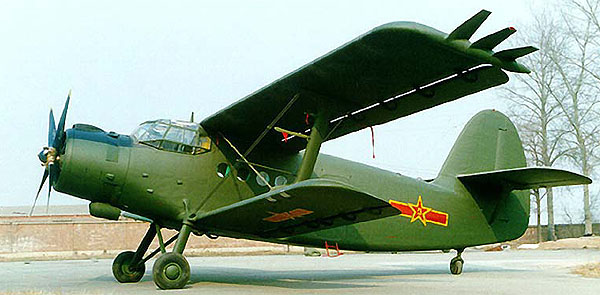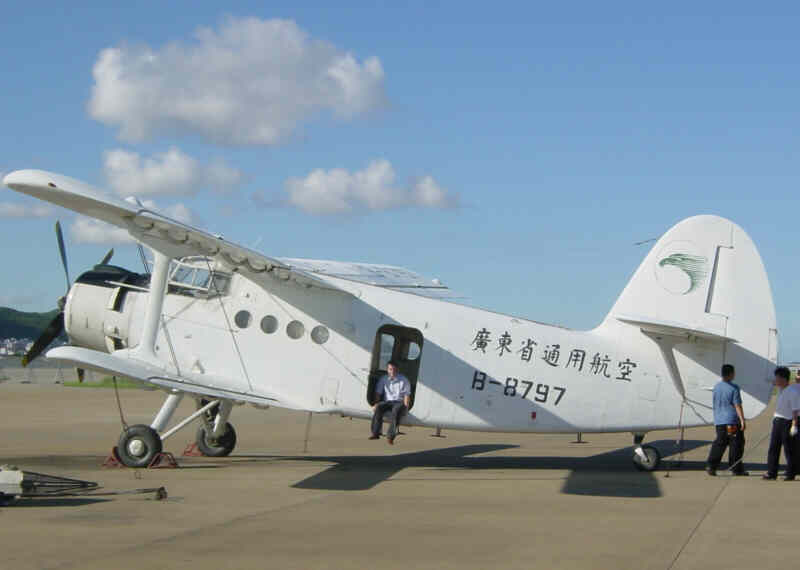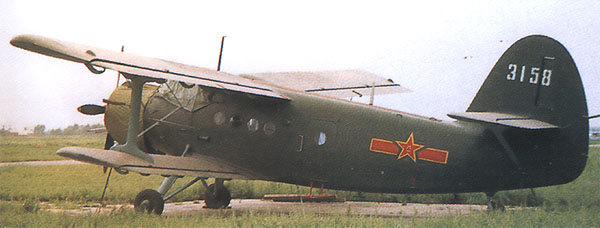
This Shijianzhuang built Y5-B is equipped with the optional "Winglet"
modification to improve
rate-of-climb. The winglets reduce drag by moving the wing tip
vortex outboard.
North Korea still operates over 200 of these aircraft and a few surviving Russian and Polish built models.
A Chinese Y-5 first flew in Dec 1957, then Nanchang was permitted to
produce the aircraft following
the guidance of the specialists and blueprints from USSR. In 1958,
the factory finished 90 Y-5s.
There were 728 Y-5s produced in the 10 years before the production
line at Nanchang 302 closed.
In May 1970, the Redstar factory at Shijiazhuang continued the
production.
Several variations of the Y-5 were produced according to the requirement
of the China Airline, Airforce
and Navy. In 1958, following USSR guidance, a variation was designed
for agricultural use. The
temperature problem of the cockpit was solved so that the Y-5 could
be widely used in South China.
This type of Y-5 was renamed Y-5B and 229 were produced during
1958. In the same year two types
of five seat aerobuses were designed for Airforce and both were produced.
Later in 1959 with the new
code "Y-5A", a 11 seat aerobus was produced for China Airline. One
hundred and fourteen were built.
Nanchang also designed the Y-5D for Airforce bombing training
in 1958 and totally produced 116 units.
In early 1960s` some special Y-5s were produced, such as a 7 seat Y-5
as a gift to Chairman Hu of
Vietnam. Two similar planes were built for Nepal`s king in Nov 1961.
A floatplane, designated as the Y-5C, was built for Navy in 1964 using
the USSR`s Aluminium alloy
pontoon design. In 1965 the pontoons were changed to Nanchang
320`s own design and 6 of these
were built for Navy.
Some Y-5s are equipped with a Chinese Huosai-H5 (1000 Hp) Engine, but
many have the Polish
built ASz-62IR-16 (1000 Hp) Engine.
In 1956, the Zhuzhou Aeroengine Factory ZEF started the production
of the HS5 engine for the Y-5,
the Chinese version of the Antonov An-2. This largest biplane
of the world had the same engine as the
Li-2 (Similar to DC-3) and gradually the Chinese Li-2's received
the Chinese engines as well. The
production of the HS5 engine was rather successful. Up to 1986
(!), more than 2,600 HS5 engines
were built, especially for the Y-5 and Li-2. Basically the engine
is the same as the 9 cylinder air
cooled Wright R.1820.
 More
Photos
More
Photos

Mongolian AN2/Y5 at Moron

PLAAF Y5 Photo by Jim Walg pictured
at Shenyang 1987

Note the Y5-C pontoon version in background.
 More
AN-2 Seaplane photos
More
AN-2 Seaplane photos
Yucheng Electronic Technology is promoting the Chinese CJ6 and Y-5B
etc. and stocks many parts
Contact: John at:
Yucheng Electronic Technology Co. Ltd.
B-3005
Xinyidai Guoji Mansion
Taibai South Road
Xi' an 710075
China
Tel: 86-29-8824-4373 Ext 8003
Fax: 86-29-8824-4025
Cell: 86-(0) 13772540541
E-Mail: John8253@yc-elec.com
Aircraft: An2/Y5
Instruments
# P/N
QTY ENGLISH DESCRIPTION
1 BG-1A
1
ALTIMETER
2 LT-1
2
AZIMUTH INSTRUMENT
3 BWH-1
4
TEMP GAUGE
4 BDP-1
3
HORIZONAL
5
2
GYRO
6 A3
1
WINDSHIELD MOTOR
7 WG-2A
2
INDICATOR
8
1
OIL PRESSURE SENSOR
9
10
FLAP SENSOR
11 DG--6
2
MOTOR
12 LQ-3
1
FILTER
13 DZ--1
11
SPARK PLUGS
14
6
BRAKE PLATE
15 DH-1
1
STARTER COIL
16 JT-5A
2
CABIN CALL
17 KTR-908 1
RADIO
18 WG-2A
ALTIMETER
19 A3
1
PUMP
20 S-3
6
FAN
21 SY-11
2
BOOSTER
22 SBL-125 2
CONVERTER
23 SBL-53
2
CONVERTER
24 WG-2A
2
INDICATOR